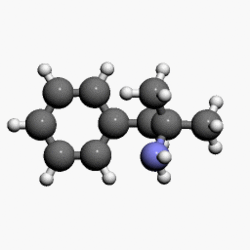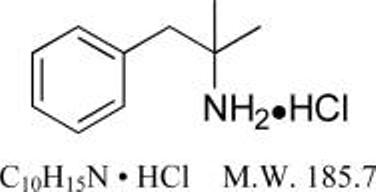Phentermine
Editor-In-Chief: C. Michael Gibson, M.S., M.D. [1]; Associate Editor(s)-in-Chief: Vignesh Ponnusamy, M.B.B.S. [2]
Disclaimer
WikiDoc MAKES NO GUARANTEE OF VALIDITY. WikiDoc is not a professional health care provider, nor is it a suitable replacement for a licensed healthcare provider. WikiDoc is intended to be an educational tool, not a tool for any form of healthcare delivery. The educational content on WikiDoc drug pages is based upon the FDA package insert, National Library of Medicine content and practice guidelines / consensus statements. WikiDoc does not promote the administration of any medication or device that is not consistent with its labeling. Please read our full disclaimer here.
Overview
Phentermine is a sympathomimetic amine anorectic that is FDA approved for the {{{indicationType}}} of exogenous Obesity. Common adverse reactions include .
Adult Indications and Dosage
FDA-Labeled Indications and Dosage (Adult)
Condition1
- Dosing Information
- Dosage
Condition2
- Dosing Information
- Dosage
Condition3
- Dosing Information
- Dosage
Condition4
- Dosing Information
- Dosage
Off-Label Use and Dosage (Adult)
Guideline-Supported Use
Condition1
- Developed by:
- Class of Recommendation:
- Strength of Evidence:
- Dosing Information
- Dosage
Condition2
There is limited information regarding Off-Label Guideline-Supported Use of Phentermine in adult patients.
Non–Guideline-Supported Use
Condition1
- Dosing Information
- Dosage
Condition2
There is limited information regarding Off-Label Non–Guideline-Supported Use of Phentermine in adult patients.
Pediatric Indications and Dosage
FDA-Labeled Indications and Dosage (Pediatric)
Condition1
- Dosing Information
- Dosage
Condition2
There is limited information regarding FDA-Labeled Use of Phentermine in pediatric patients.
Off-Label Use and Dosage (Pediatric)
Guideline-Supported Use
Condition1
- Developed by:
- Class of Recommendation:
- Strength of Evidence:
- Dosing Information
- Dosage
Condition2
There is limited information regarding Off-Label Guideline-Supported Use of Phentermine in pediatric patients.
Non–Guideline-Supported Use
Condition1
- Dosing Information
- Dosage
Condition2
There is limited information regarding Off-Label Non–Guideline-Supported Use of Phentermine in pediatric patients.
Contraindications
- History of cardiovascular disease (e.g., coronary artery disease, stroke, arrhythmias, congestive heart failure, uncontrolled hypertension)
- During or within 14 days following the administration of monoamine oxidase inhibitors
- Hyperthyroidism
- Glaucoma
- Agitated states
- History of drug abuse
- Pregnancy
- Nursing
- Known hypersensitivity, or idiosyncrasy to the sympathomimetic amines
Warnings
Precautions
- Coadministration with Other Drug Products for Weight Loss
- Phentermine hydrochloride tablets are indicated only as short-term (a few weeks) monotherapy for the management of exogenous obesity. The safety and efficacy of combination therapy with phentermine and any other drug products for weight loss including prescribed drugs, over-the-counter preparations, and herbal products, or serotonergic agents such as selective serotonin reuptake inhibitors (e.g., fluoxetine, sertraline, fluvoxamine, paroxetine), have not been established. Therefore, coadministration of phentermine and these drug products is not recommended.
- Primary Pulmonary Hypertension
- Primary Pulmonary Hypertension (PPH) - a rare, frequently fatal disease of the lungs - has been reported to occur in patients receiving a combination of phentermine with fenfluramine or dexfenfluramine. The possibility of an association between PPH and the use of phentermine alone cannot be ruled out; there have been rare cases of PPH in patients who reportedly have taken phentermine alone. The initial symptom of PPH is usually dyspnea. Other initial symptoms may include angina pectoris, syncope or lower extremity edema. Patients should be advised to report immediately any deterioration in exercise tolerance. Treatment should be discontinued in patients who develop new, unexplained symptoms of dyspnea, angina pectoris, syncope or lower extremity edema, and patients should be evaluated for the possible presence of pulmonary hypertension.
- Valvular Heart Disease
- Serious regurgitant cardiac valvular disease, primarily affecting the mitral, aortic and/or tricuspid valves, has been reported in otherwise healthy persons who had taken a combination of phentermine with fenfluramine or dexfenfluramine for weight loss. The possible role of phentermine in the etiology of these valvulopathies has not been established and their course in individuals after the drugs are stopped is not known. The possibility of an association between valvular heart disease and the use of phentermine alone cannot be ruled out; there have been rare cases of valvular heart disease in patients who reportedly have taken phentermine alone.
- Development of Tolerance, Discontinuation in Case of Tolerance
- When tolerance to the anorectant effect develops, the recommended dose should not be exceeded in an attempt to increase the effect; rather, the drug should be discontinued.
- Effect on the Ability to Engage in Potentially Hazardous Tasks
- Phentermine may impair the ability of the patient to engage in potentially hazardous activities such as operating machinery or driving a motor vehicle; the patient should therefore be cautioned accordingly.
- Risk of Abuse and Dependence
- Phentermine is related chemically and pharmacologically to amphetamine (d- and d/l-amphetamine) and other related stimulant drugs that have been extensively abused. The possibility of abuse of phentermine should be kept in mind when evaluating the desirability of including a drug as part of a weight reduction program. See Drug Abuse and Dependence (9) and Overdosage (10).
- The least amount feasible should be prescribed or dispensed at one time in order to minimize the possibility of overdosage.
- Usage with Alcohol
- Concomitant use of alcohol with phentermine may result in an adverse drug reaction.
- Use in Patients with Hypertension
- Use caution in prescribing phentermine for patients with even mild hypertension (risk of increase in blood pressure).
- Use in Patients on Insulin or Oral Hypoglycemic Medications for Diabetes Mellitus
- A reduction in insulin or oral hypoglycemic medications in patients with diabetes mellitus may be required.
Adverse Reactions
Clinical Trials Experience
- The following adverse reactions to phentermine have been identified:
Cardiovascular
Primary pulmonary hypertension and/or regurgitant cardiac valvular disease, palpitation, tachycardia, elevation of blood pressure, ischemic events.
Central Nervous System
Overstimulation, restlessness, dizziness, insomnia, euphoria, dysphoria, tremor, headache, psychosis.
Gastrointestinal
Dryness of the mouth, unpleasant taste, diarrhea, constipation, other gastrointestinal disturbances.
Allergic
Urticaria.
Endocrine
Impotence, changes in libido.
Postmarketing Experience
There is limited information regarding Postmarketing Experience of Phentermine in the drug label.
Drug Interactions
- Monoamine Oxidase Inhibitors
- Use of phentermine is contraindicated during or within 14 days following the administration of monoamine oxidase inhibitors because of the risk of hypertensive crisis.
- Alcohol
- Concomitant use of alcohol with phentermine may result in an adverse drug reaction.
- Insulin and Oral Hypoglycemic Medications
- Requirements may be altered [see Warnings and Precautions (5.9)].
- Adrenergic Neuron Blocking Drugs
- Phentermine may decrease the hypotensive effect of adrenergic neuron blocking drugs.
Use in Specific Populations
Pregnancy
- Pregnancy Category X
- Phentermine is contraindicated during pregnancy because weight loss offers no potential benefit to a pregnant woman and may result in fetal harm. A minimum weight gain, and no weight loss, is currently recommended for all pregnant women, including those who are already overweight or obese, due to obligatory weight gain that occurs in maternal tissues during pregnancy. Phentermine has pharmacologic activity similar to amphetamine (d- and d/l-amphetamine) [see Clinical Pharmacology (12.1)]. Animal reproduction studies have not been conducted with phentermine. If this drug is used during pregnancy, or if the patient becomes pregnant while taking this drug, the patient should be apprised of the potential hazard to a fetus.
- Australian Drug Evaluation Committee (ADEC) Pregnancy Category
There is no Australian Drug Evaluation Committee (ADEC) guidance on usage of Phentermine in women who are pregnant.
Labor and Delivery
There is no FDA guidance on use of Phentermine during labor and delivery.
Nursing Mothers
- It is not known if phentermine is excreted in human milk; however, other amphetamines are present in human milk. Because of the potential for serious adverse reactions in nursing infants, a decision should be made whether to discontinue nursing or to discontinue the drug, taking into account the importance of the drug to the mother.
Pediatric Use
- Safety and effectiveness in pediatric patients have not been established. Because pediatric obesity is a chronic condition requiring long-term treatment, the use of this product, approved for short-term therapy, is not recommended.
Geriatic Use
- In general, dose selection for an elderly patient should be cautious, usually starting at the low end of the dosing range, reflecting the greater frequency of decreased hepatic, renal, or cardiac function, and of concomitant disease or other drug therapy.
- This drug is known to be substantially excreted by the kidney, and the risk of toxic reactions to this drug may be greater in patients with impaired renal function. Because elderly patients are more likely to have decreased renal function, care should be taken in dose selection, and it may be useful to monitor renal function.
Gender
There is no FDA guidance on the use of Phentermine with respect to specific gender populations.
Race
There is no FDA guidance on the use of Phentermine with respect to specific racial populations.
Renal Impairment
- Phentermine was not studied in patients with renal impairment. Based on the reported excretion of phentermine in urine, exposure increases can be expected in patients with renal impairment. Use caution when administering phentermine to patients with renal impairment.
Hepatic Impairment
There is no FDA guidance on the use of Phentermine in patients with hepatic impairment.
Females of Reproductive Potential and Males
There is no FDA guidance on the use of Phentermine in women of reproductive potentials and males.
Immunocompromised Patients
There is no FDA guidance one the use of Phentermine in patients who are immunocompromised.
Administration and Monitoring
Administration
- Oral
Monitoring
There is limited information regarding Monitoring of Phentermine in the drug label.
IV Compatibility
There is limited information regarding IV Compatibility of Phentermine in the drug label.
Overdosage
Acute Overdose
Signs and Symptoms
- Manifestations of acute overdosage include restlessness, tremor, hyperreflexia, rapid respiration, confusion, assaultiveness, hallucinations, and panic states. Fatigue and depression usually follow the central stimulation. Cardiovascular effects include tachycardia, arrhythmia, hypertension or hypotension, and circulatory collapse. Gastrointestinal symptoms include nausea, vomiting, diarrhea and abdominal cramps. Overdosage of pharmacologically similar compounds has resulted in fatal poisoning usually terminates in convulsions and coma.
Management
- Management of acute phentermine hydrochloride intoxication is largely symptomatic and includes lavage and sedation with a barbiturate. Experience with hemodialysis or peritoneal dialysis is inadequate to permit recommendations in this regard. Acidification of the urine increases phentermine excretion. Intravenous phentolamine (Regitine®, CIBA) has been suggested on pharmacologic grounds for possible acute, severe hypertension, if this complicates overdosage.
Chronic Overdose
- Manifestations of chronic intoxication with anorectic drugs include severe dermatoses, marked insomnia, irritability, hyperactivity and personality changes. The most severe manifestation of chronic intoxications is psychosis, often clinically indistinguishable from schizophrenia.
Pharmacology
 | |
 | |
| Clinical data | |
|---|---|
| Trade names | Adipex-p, Duromine, Metermine, Suprenza |
| Synonyms | α-methyl-amphetamine α,α-dimethylphenethylamine |
| AHFS/Drugs.com | Monograph |
| MedlinePlus | a682187 |
| Pregnancy category | |
| Routes of administration | Medical: oral, Recreational: oral, insufflation, intravenous |
| ATC code | |
| Legal status | |
| Legal status |
|
| Pharmacokinetic data | |
| Bioavailability | High (almost complete)[1] |
| Protein binding | Approximately 96.3% |
| Metabolism | Hepatic[1] |
| Elimination half-life | 25 hours, urinary pH-dependent[1] |
| Excretion | Urinary (62-85% unchanged)[1] |
| Identifiers | |
| |
| CAS Number | |
| PubChem CID | |
| DrugBank | |
| ChemSpider | |
| UNII | |
| KEGG | |
| ChEBI | |
| ChEMBL | |
| E number | {{#property:P628}} |
| ECHA InfoCard | {{#property:P2566}}Lua error in Module:EditAtWikidata at line 36: attempt to index field 'wikibase' (a nil value). |
| Chemical and physical data | |
| Formula | C10H15N |
| Molar mass | 149.233 g/mol |
| 3D model (JSmol) | |
| |
| |
| (verify) | |
Mechanism of Action
- Phentermine is a sympathomimetic amine with pharmacologic activity similar to the prototype drugs of this class used in obesity, amphetamine (d- and d/l-amphetamine). Drugs of this class used in obesity are commonly known as "anorectics" or "anorexigenics." It has not been established that the primary action of such drugs in treating obesity is one of appetite suppression since other central nervous system actions, or metabolic effects, may also be involved.
Structure
- Phentermine hydrochloride USP is a sympathomimetic amine anorectic. Its chemical name is a,a-dimethylphenethylamine hydrochloride. The structural formula is as follows:
- Phentermine hydrochloride USP is a white, odorless, hygroscopic, crystalline powder which is soluble in water and lower alcohols, slightly soluble in chloroform and insoluble in ether.
- Phentermine hydrochloride tablets USP are available as an oral tablet containing 37.5 mg of phentermine hydrochloride USP (equivalent to 30 mg of phentermine base). Each phentermine hydrochloride tablet USP also contains the inactive ingredients microcrystalline cellulose, pregelatinized starch, anhydrous lactose, crospovidone, colloidal silicon dioxide, magnesium stearate, sucrose, corn starch and FD&C Blue #1.
Pharmacodynamics
There is limited information regarding Pharmacodynamics of Phentermine in the drug label.
Pharmacokinetics
There is limited information regarding Pharmacokinetics of Phentermine in the drug label.
Nonclinical Toxicology
There is limited information regarding Nonclinical Toxicology of Phentermine in the drug label.
Clinical Studies
There is limited information regarding Clinical Studies of Phentermine in the drug label.
How Supplied
Storage
There is limited information regarding Phentermine Storage in the drug label.
Images
Drug Images
{{#ask: Page Name::Phentermine |?Pill Name |?Drug Name |?Pill Ingred |?Pill Imprint |?Pill Dosage |?Pill Color |?Pill Shape |?Pill Size (mm) |?Pill Scoring |?NDC |?Drug Author |format=template |template=DrugPageImages |mainlabel=- |sort=Pill Name }}
Package and Label Display Panel
{{#ask: Label Page::Phentermine |?Label Name |format=template |template=DrugLabelImages |mainlabel=- |sort=Label Page }}
Patient Counseling Information
There is limited information regarding Patient Counseling Information of Phentermine in the drug label.
Precautions with Alcohol
- Alcohol-Phentermine interaction has not been established. Talk to your doctor about the effects of taking alcohol with this medication.
Brand Names
- ®[2]
Look-Alike Drug Names
- A® — B®[3]
Drug Shortage Status
Price
References
The contents of this FDA label are provided by the National Library of Medicine.
{{#subobject:
|Page Name=Phentermine |Pill Name=No image.jpg |Drug Name= |Pill Ingred=|+sep=; |Pill Imprint= |Pill Dosage= |Pill Color=|+sep=; |Pill Shape= |Pill Size (mm)= |Pill Scoring= |Pill Image= |Drug Author= |NDC=
}}
{{#subobject:
|Label Page=Phentermine |Label Name=Phentermine11.png
}}
{{#subobject:
|Label Page=Phentermine |Label Name=Phentermine11.png
}}
- Pages with script errors
- Pages with reference errors
- Pages with empty citations
- CS1 errors: external links
- Template:drugs.com link with non-standard subpage
- E number from Wikidata
- ECHA InfoCard ID from Wikidata
- Chemical articles with unknown parameter in Infobox drug
- Drugboxes which contain changes to watched fields
- Drug
